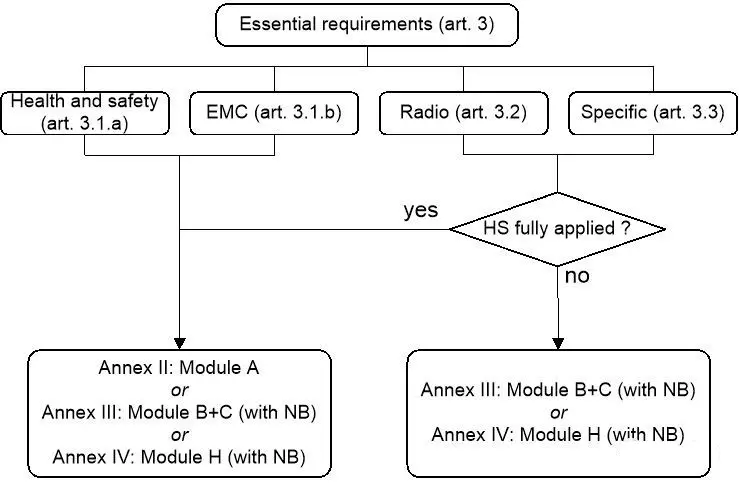
What is the Radio Equipment Directive (RED)?
EU Radio Equipment Directive 2014/53/EU
The Radio Equipment Directive applies to electrical and electronic devices designed to transmit and/or receive radio waves. Examples of radio equipment include TVs, mobile phones, Bluetooth and Wi-Fi devices, and IoT devices. The official English version of the Radio Equipment Directive can be downloaded:
Design Requirements for Radio Equipment
1. Meet the requirements of the Low Voltage Directive, excluding voltage limits.
2. Ensure adequate electromagnetic compatibility as described in the EMC Directive.
3. Use the radio spectrum effectively and efficiently.
The directive also specifies additional requirements for certain radio equipment, covering issues such as the protection of personal data and privacy, as well as access to emergency services. Additional requirements may be determined by the European Commission in the future.
By attaching the CE mark to radio equipment, manufacturers or importers declare that the product complies with the essential requirements of the Radio Equipment Directive 2014/35/EU. Radio equipment bearing the CE mark can be freely traded within the European Economic Area (EEA).
Scope of the RED Directive
It covers all radio equipment operating at frequencies below 3000 GHz, including short-range devices, broadband equipment, and mobile communication devices. It also applies to radio equipment used solely for sound reception and TV broadcasting services (such as FM radios and televisions). For instance, this includes devices like 27.145 MHz remote-controlled toys, 433.92 MHz remote controls, 2.4 GHz Bluetooth ovens, and 2.4 GHz/5 GHz Wi-Fi-enabled air conditioners and smartphones.
Exemptions from the RED Directive include:
- Amateur radio equipment,
- Maritime equipment (see Directive 2014/90/EU),
- Aeronautical products, parts, and equipment (see Regulation (EC) No 216/2008),
- Custom-built evaluation kits,
- Radio equipment for public safety, defense, and national security.
Declaration of Conformity (DoC) for RED Compliance
Every radio product sold in the EU must have a Declaration of Conformity (DoC). This document should be updated as needed and translated into the language(s) required by the member state where the device will be used. The RED Directive standards in the Official Journal (OJ) cover spectrum, EMC, and electrical safety.
Steps for doc compliance:
1. Identify the item, including its type, batch, and serial number. Color photos are recommended.
2. Provide the name and address of the manufacturer or authorized representative.
3. Include the statement: "This declaration is issued under the sole responsibility of the manufacturer." It should state that the product conforms to the relevant EU harmonization legislation, specifically Directive 2014/53/EU.
4. Reference applicable harmonized standards or other technical specifications used in the assessment.
5. Include the name and number of the notified body that conducted the assessment and the resulting EU-type examination certificate.
6. List transmitter frequency (e.g., MHz) and output power (e.g., mW).
7. Describe the accessories and software that enable the equipment to operate as intended.
8. Have the document signed and dated by a responsible person within the organization.
9. The Declaration of Conformity is an essential part of the technical documentation required for the product. See Annex V of the RED Directive 2014-53-EU for the full technical documentation list.
CE-RED Certification Model

RED Test Standards Reference
1. Operating Frequency: 25MHz-1000MHz (27MHz, 433MHz, 868MHz products)
- EN300220 (RF Testing)
- EN301489-7 (EMC Testing)
- EN60950-1: 2006 (Safety Testing)
- EN50371 (Harm Assessment)
2. Operating Frequency: 1000MHz-40GHz (2.4GHz products)
- EN300440 (RF Testing)
- EN301489-7 (EMC Testing)
- EN60950-1: 2006 (Safety Testing)
- EN50371 (Harm Assessment)
3. Operating Frequency: ISM band (Wi-Fi, Bluetooth products)
- EN300328 (RF Testing)
- EN301 489-17 (EMC Testing)
- EN60950-1: 2006 (Safety Testing)
- EN62311 (Harm Assessment)
4. Operating Frequency: GSM band (mobile phones, GPS locators, terminals)
- EN301 511 (RF Testing)
- EN301 489-7 (EMC Testing)
- EN50360: 2001
- EN62209-1:2006 (sar testing)
- EN60950-1: 2006 (Safety Testing)
5. Operating Frequency: Walkie-talkie products
- EN301489 (EMC Testing)
- EN300296 (Civilian Walkie-Talkie RF Testing)
- EN300086 (Professional Walkie-Talkie RF Testing)
- EN60065 (Safety Testing)
- EN50360/ EN50361 (SAR Testing)
6. Operating Frequency: 88.1-107.9 FM Transmitters
- EN 3001357 (RF Testing)
- EN301 489-1/9 (EMC Testing)
- EN60950-1: 2006 (Safety Testing)
- EN50371 (Harm Assessment)
7. Operating Frequency: Wireless Microphone
- EN 300422-1/-2 (RF Testing)
- EN301489-1/-9 (EMC Testing)
- EN60950-1 (Safety Testing)
- EN50371 (Harm Assessment)
8. Operating Frequency: WCDMA 3G products (e.g., mobile phones, 3G routers)
- EN301908-1 (RF Testing)
- EN301908-2 (RF Testing)
- EN301 489-24 (EMC Testing)
- EN50360.50361: 2001 (SAR Testing)
- EN60950-1: 2006 (Safety Testing)
RED Test Items
1. EMC Testing
2. LVD Safety Testing (for battery-powered RF products as well)
3. Wireless Communication Equipment Testing based on ETSI standards (RF Testing)
4. European Spectrum Information Notification
5. CTR (TBR) Testing
6. Electrical Safety and Health Protection Testing (SAR Assessment)
CE Marking for Radio Equipment: Six Steps (RED)
1. Product Classification
2. Classification of Economic Operators
3. Conformity Procedures
- Test/evaluate products per harmonized European standards
- Ensure consistency in mass production
- Provide identification for products and economic operators
- Offer user and safety information
- Set corrective action procedures
4. Technical Documentation
5. EU Declaration of Conformity
6. CE Marking
Each radio product sold in the EU must have a Declaration of Conformity (DoC).
Email:hello@jjrlab.com
Write your message here and send it to us
 Toothbrush FDA Certification Testing
Toothbrush FDA Certification Testing
 Snoring Device FDA 510k Standard Testing
Snoring Device FDA 510k Standard Testing
 Single Use Intravenous Catheter Certification Test
Single Use Intravenous Catheter Certification Test
 Silicone Material Product Compliance Certification
Silicone Material Product Compliance Certification
 What to Do If Cytotoxicity Test Results Are Positi
What to Do If Cytotoxicity Test Results Are Positi
 ISO 10993:5 Cytotoxicity Testing Methods
ISO 10993:5 Cytotoxicity Testing Methods
 FDA ISO 10993-1 Biocompatibility Evaluation Guidel
FDA ISO 10993-1 Biocompatibility Evaluation Guidel
 In Vitro Cytotoxicity Testing for Medical Devices
In Vitro Cytotoxicity Testing for Medical Devices
Leave us a message
24-hour online customer service at any time to respond, so that you worry!




